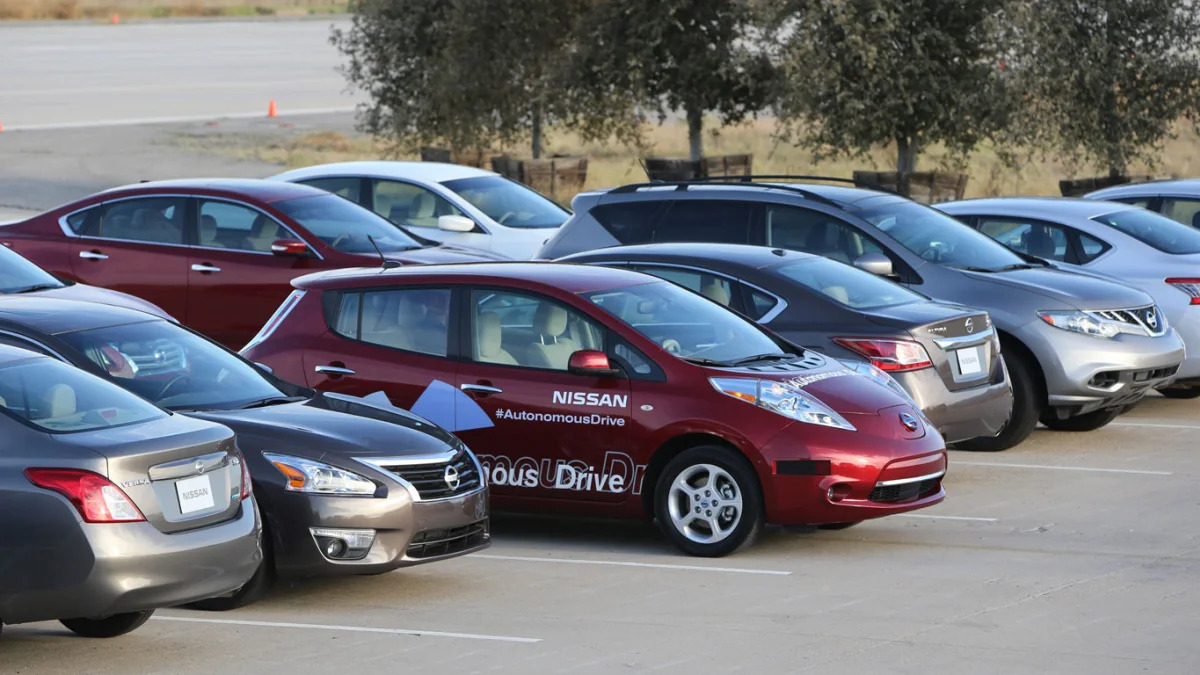Nissan Searches For Identity In America

-

- Image Credit: Nissan
Nissan is a familiar brand name to the majority of car-buying Americans, as well as being the sixth largest car company in the world. Still, you might be surprised at how difficult it can be for the Japanese company to earn respect and consideration from buyers who are also shopping Toyotas, Hondas, Fords--companies with clearer brand images--without putting a lot of rebates and incentives in the deal for a consumer.
Pushing its Leaf electric vehicle and trying to market the first commercially available "autonomous" car, Nissan is trying to carve out an image for technological leadership. Most of all, Nissan is trying to find a story it can tell to American car buyers that might help get its market share from 8% through September, according to Autodata, to 10% and up where CEO Carlos Ghosn says it must be to be profitable and successful. To that end, Nissan has had reporters, including AOL Autos, out to California for a full-on deep-dive review of the company's current and future offerings and technology, as well as cars it sells around the world. Here is what we drove and learned. -
- Image Credit: Nissan
Autonomous Nissan LEAF
Should I be concerned? I am the front passenger in a Nissan Leaf and the 'driver' has just got out to prove the car can drive itself. We are stopped next to a group of twenty or so parked cars. Down one aisle I can see an empty parking spot between two vehicles. Our driver presses a button on the key fob and our car starts to move into the aisle, stops just beyond the open spot and then carefully reverses into the space. A few moments later the driver, standing 30 yards away, presses the fob and our car exits the parking space and returns to his side. During the whole process, the car drove itself.
[See our Translogic episode on what it's like to drive Nissan's "Car of Tomorrow."]
The exercise was a glimpse at the autonomous driving technology Nissan is developing as it strives to be one of the first, if not the first, automaker to put a self-driving automobile into production. Nissan has some tough competition; rival automakers from Mercedes to Tesla, not to mention tech giants such as Google, are working on related systems.
Nissan CEO Carlos Ghosn has stated publicly that he is aiming to have the first commercially viable autonomous vehicle ready by 2020. That's just around the corner in automotive terms, but to judge by the various exercises the Leaf demonstrated--self-parking, overtaking, reading traffic lights, avoiding a pedestrian darting out into the road--Nissan is well on the way to making the driver superfluous.
The Autonomous Leaf demo car is loaded with sensors, cameras and side-mounted laser scanners (plus a trunk full of computers) to help it 'see' and react to its surroundings. According to the Nissan engineers, the technology to make autonomous cars a reality exists today. What's needed is a lot more development time and official acceptance of the concept--currently only three US states, Nevada, Florida and California--allow autonomous cars on public roads for research purposes.
Expect the road to self-driving cars to be marked in progressive steps as automakers roll out elements of the technology over the next few years.The day you can leave your car to park itself is not here yet but it's not far off. -
- Image Credit: Nissan
Nissan LEAF NISMO RC
You may have heard that all-electric cars like the Leaf are fast off the line because they produce full power from a dead stop. So, imagine the same energy in a super lightweight car. That's what you get in the Leaf Nismo RC, the same 107-horsepower slotted into a Lotus Evora chassis and clothed in a low slung fiberglass shell that looks vaguely like a Leaf. The result feels fast (at least up to 40mph or so), quiet by race-car standards and corners flat like a pumped up go-kart on racing slick tires. It's surprisingly fun to drive and an indication of the potential for an electric race-car, although in this case the Nismo RC runs out of juice after about twenty minutes at racing speeds.
-
- Image Credit: Nissan
Nissan GT-R
In its newest 2014 iteration, the GT-R offers "world class performance at half the price of its supercar rivals," boasts Nissan. With 545-horsepower from a twin-turbocharged V-6 and all-wheel drive, the GT-R is blisteringly quick--think 2.7 seconds 0-60mph. But while the GT-R's technology is sophisticated, it has a savage edge to its driving character and its brash design is not be confused with a Ferrari. For 2014, the standard version of the GT-R starts at $99,590, with a specially equipped Track edition priced from $115,710.
-
- Image Credit: Nissan
Nissan GT-R GT3
If the regular GT-R super sports car is too tame, you can always try the GT-R GT3 race-car if you can get your hands on one. With 550-horsepower and lightweight body, Nissan thought it inadvisable to let mere journalists drive the car, but one could only ride along with a very young looking hot-shoe driver, who also happened to be a winner at the Nissan GT Academy. This program takes Playstation racing video-game champs and turns them into real race-car drivers. Vroom! So, the riveting experience of hurtling round a track takes on a new dimension when you realize the driver learned his trade at a computer screen.
-
- Image Credit: Nissan
Infiniti Q50S Hybrid
One of Infiniti's newest showroom offerings we can buy now is the Q50S hybrid. Quite swift off the mark (0-60mph in 5.3 seconds) due to its combination of conventional gasoline engine and electric motors, the Q50S is one of the more engaging hybrids on the market. Its BMW 3-Series dimensions, impressive equipment list and taut handling may help put Infiniti's sales back on an upward trajectory.




